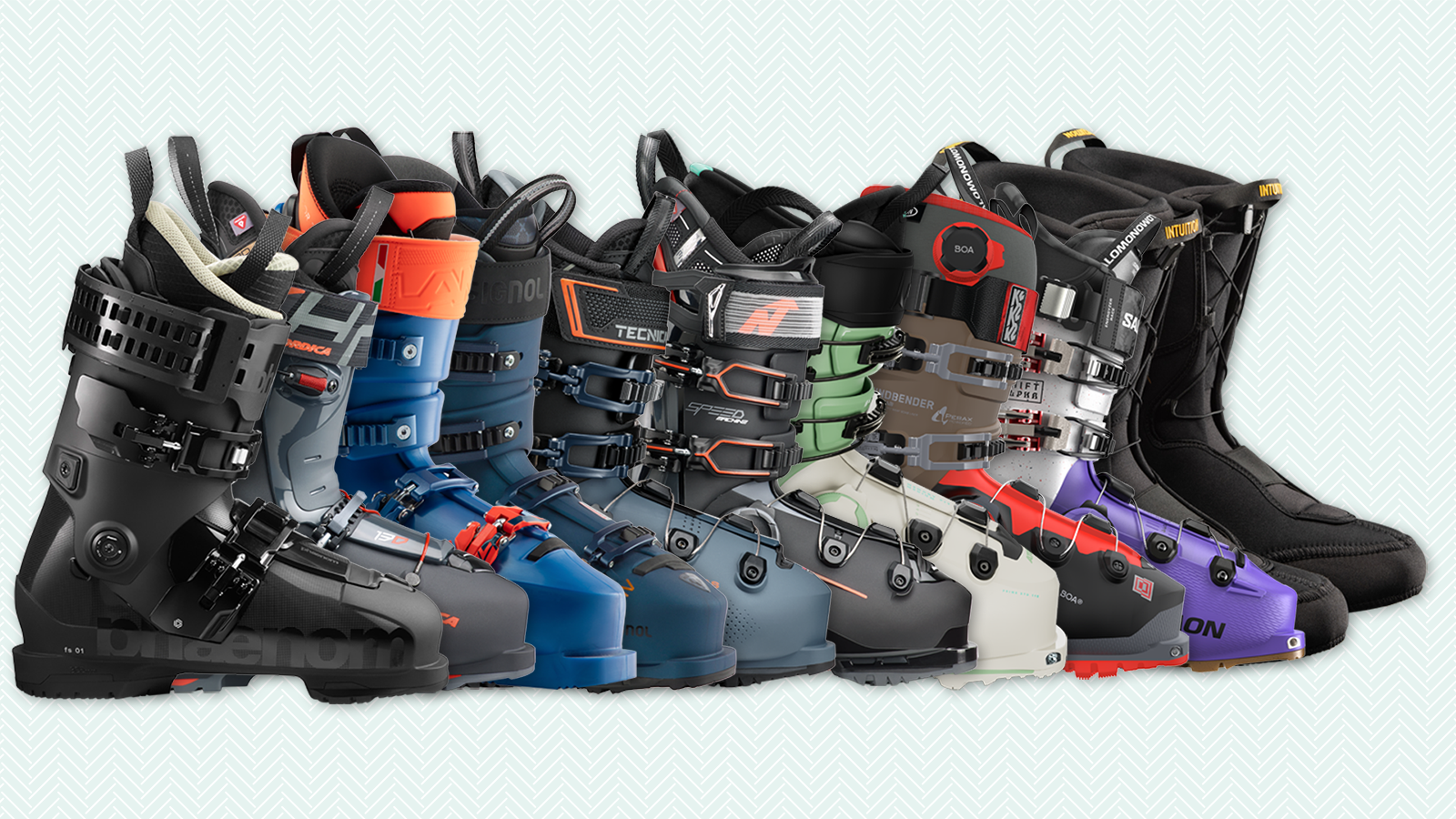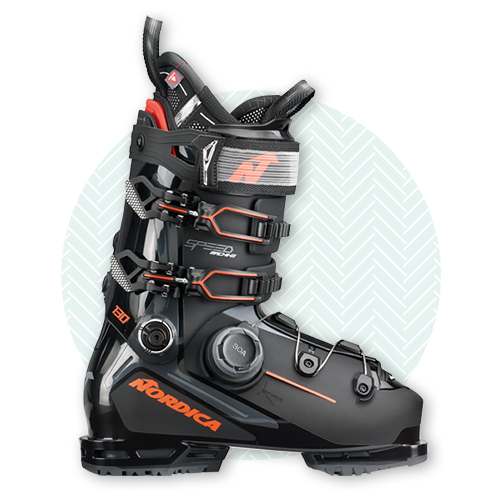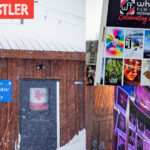
OOOH, IT FITS SO GOOD
We haven’t seen so much innovation in ski boots since, maybe, Bob Lange introduced plastic shells in 1962. Since that time we’ve cranked them tight with an assortment of buckles that all worked in roughly the same way. No longer.
The BOA dial, introduced in four boots last year, will dominate shop walls this winter. Salomon, Atomic, K2 and Fischer are all expanding their initial BOA offerings and Technica and Nordica are joining the party.
The dial arguably does a better job of adjusting the boot fit, which is part of a larger trend toward comfort. Brands have worked hard to add more customization options and make ergonomic lasts that fit more feet right out of the box.
Meanwhile, two brands are going back in time, re-releasing the rear-entry style boots that were popular during the ‘80s and ‘90s. And a brand new boot maker has developed something a little different.
Heading in the other direction, lightweight backcountry boots are fading. Instead, the backcountry curious are buying touring-capable, resort-style boots like Scarpa’s 4-Quattro Pro, Tecnica’s Zero G Tour Pro (which includes a women’s 125 flex model for the first time) and the Salomon Sift Alpha BOA, which combines multiple trends. We’ll report more on these boots in the Powder Buyer’s Guide.
BUCKLING UNDER BOA
Viva the BOA revolution! The dial is a good thing for better-fitting boots. All BOA boots work roughly the same way: the cable takes over for buckles on the lower boot. Turning a dial that sits near the ankle joint tightens a zig-zagging cable to pull the overlapping layers of plastic together, rather than push down as buckles tend to. It’s more adjustable and offers a more precise fit.
•••

K2 BOA BLOWOUT
_ They haven’t bet the pot, but K2 is committed to BOA like no one else, adding the dial to four of its boot families: the comfort-focused BFC, the all-mountain Recon, the women’s Anthem and the freeride Mindbender. The latter includes a super-stiff 140-flex option. The Recon, Anthem and Mindbinder double up, with a BOA dial on the heat-mouldable Intuition liner as well as a BOA dial in place of the bottom two buckles.
•••

SALOMON SHIFT ALPHA BOA
_ The BOA dial came to ski boots in the backcountry first and Salomon is taking it back there in a new way. On the Shift Alpha, the BOA dial remains on the lower shell, but the rest of the boot is touring-oriented with a new spine that Salomon says does a better job of connecting the lower and upper boot when in ski mode.
•••

NORDICA SPEEDMACHINE 3 BOA
_ Nordica is entering the BOA game by adding the dial to five models (three men’s, two women’s) of the Speedmachine. The new all-mountain boots have Tri Force Frame construction, which positions three densities of plastic in the shell to balance precision, power and comfort.
•••

ATOMIC HAWX PRIME XTD BOA
_ The Hawx Prime family of boots (100mm last) now includes a BOA option. The all-mountain boot has an easy entry design and a heat-mouldable liner. The Hawx Prime BOA family is deep, with two distinct models and several different stiffnesses for both men and women.
•••

TECNICA MACH BOA
_ Tecnica figures the BOA’s ability to wrap the shell, rather than compress it, is most beneficial for people with large feet. So rather than offer the dial to the medium- and low-volume versions of the all-mountain Mach boot line, they are only introducing it in the high-volume HV collection.
COMFORT AND PERFORMANCE
The advent of BOA is only one aspect of the relentless and oh-so-welcome march towards better-fitting ski boots. Several other new boots are innovating in different ways.
•••

NORDICA HF PRO
_ This sleek boot is all about convenience and performance. Nordica has had the HF in its line for a few years. It has a rear-entry mechanism that opens the back of the boot widely enough for slipping on the boot (no contortion or pressure necessary). A cable system and single buckle adjusts and sets the fit (no fiddling with multiple buckles). This year, Nordica refined the construction to make the Pro stiffer and more precise, so there’s less downside to choosing ease and comfort.
•••

ROSSIGNOL VIZION
_ The Vizion is a rear-entry boot in disguise–it only took four patents. It boasts rear-entry ease, but with four buckles it looks and skis like a regular two-piece boot. Opening the middle buckle releases the back of the boot to hinge wide, while an elastic area on the removable liner allows it to follow suit. After slipping the foot in, close the buckle and a steel spine anchors the cuff. The Vizion is available in a variety of stiffnesses, with women’s and men’s lasts.
•••

LANGE RS
_ Lange’s new race-focused RS ski boots are all about finding tenths of a second. Testing in wind tunnels helped designers refine the shape of the shell and develop new buckles to reduce drag. Out on the snow, skiers can fine-tune the stiffness of the boot with an adjustable plate. It replaces the screws that usually hold the upper and lower shells together, adding a rare level of customization.
•••

PHAENOM FOOTWEAR FS 01 120
_ Here’s a new take on a ski boot from a new ski boot brand. The parent company behind Faction Skis launched Phaenom last winter with two boots, the all-mountain/freeride FS 01 120 (which we tested) and a stiffer, touring-capable FR 01 130. The FS stands out with an oversized, rubber power strap, two chunky buckles and a hybrid cabrio-overlap design. Everything feels overbuilt and burly and all the parts are replaceable. This speaks to Phaenom’s sustainability focus. The all-black shell is more easily recycled at the end of its life and the liner includes 50 percent recycled parts. The liner is also unusual. It features a grippy sole, which encourages use as a shoe off the slopes. After we heat-moulded the liner, the 102mm last fit snugly on a narrow ankle and roomy on a fat forefoot. With the buckles and strap pulled tight it has a precise feel that’s hefty, but not overly rigid.
•••

DALBELLO VELOCE
_ The Veloce are all dressed. Dalbello uses a harder plastic on the lower shell for power transmission, a softer plastic on the upper to make it easier to get the boots on and thinner plastic in typical trouble zones to make customization easier. There’s memory foam in the tongue and Primaloft in the liner and footbed for warmth. The women’s version looks the most luxurious with a faux fur lining.
•••

BEFORE YOU BUY NEW BOOTS
_ Here’s a money-saving tip: Ski boot liners don’t last as long as exterior plastic shells. A new liner, like the heat-moldable ones by Intuition Liners, will make your old ski boots feel new again—and maybe even better.
That’s because most ski boot liners are optimized to feel comfortable when trying them on in the store, not on the slopes, says Intuition’s Ben Mills. Otherwise we wouldn’t buy them. For its aftermarket liners, Intuition assumes customers are more interested in an optimal fit, so the Vancouver-based company uses a stiffer, higher performance foam.
With advice from Mills, we swapped in new Intuition liners last winter. We could choose between two foam densities and different liner designs in order to dial in the fit. Once the liners arrived, it was easy to mold the liners at home. At first, the Intuition liners felt less plush than the originals, but once we were on snow they were easily as warm and comfortable, and they noticeably increased the boot’s fit and responsiveness.
GET MORE BUYER’S GUIDE:




